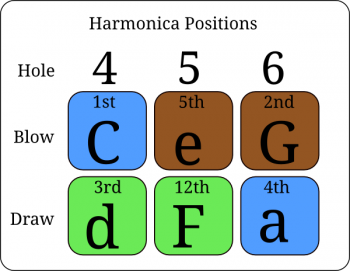|
Dirty-South Blues Harp forum: wail on! >
A minor Pentatonic, E minor Pent, D minor Pent
A minor Pentatonic, E minor Pent, D minor Pent
Page:
1
528hemi
365 posts
May 30, 2013
5:28 AM

|
Are the relative minor scales used?
My understanding is the relative minor scales use the same notes but the relative minor starts with the 6th of the major note.
C major =A minor
G major = E minor
F major = D minor
Can these minor scales work if the band is playing a blues in A,E or D? trying to understand when one might want to use these scales.
Any examples of songs for Harp that use the minor Pentotonic scales that you can think of?
Thank you,
528hemi
|
arzajac
1061 posts
May 30, 2013
5:56 AM

|
Yes, they can! The minor pentatonic is just one note short of the blues scale. And playing the relative major/minor of the chord/scale being played (by the band) can work and can add a layer of texture and serve as a source of new ideas and inspiration.
I know Jason Ricci is really big on playing pentatonic scales and using rhythm as the major source of musicality.
Here are two pages on the six pentatonic scales you can easily access on a standard Richter harp:
How to play six keys on a diatonic harmonica without overblows using Pentatonic scales
The middle octave, positions and pentatonic scales on the diatonic harmonica
The second page just serves to point out that the middle octave is a great reference point to the tonic notes of these six scales. These notes are all unbent in that octave.
Each color represents a breath pattern so both the major and minor pentatonic scales share the same breath pattern.

----------

Last Edited by arzajac on May 30, 2013 6:00 AM
|
timeistight
1242 posts
May 30, 2013
9:46 AM

|
As arzajac writes, you can convert a minor pentatonic to a blues scale by adding one note, the diminished fifth. To use your example scales:
A minor pentatonic = A, C, D, E, G. Add Eb makes
A blues scale = A, C, D, Eb, E, G.
E minor pentatonic = E, G, A, B, D. Add Bb makes
E blues scale = E, G, A, Bb, B, D.
D minor pentatonic = D, F, G, A, C. Add Ab makes
D blues scale = D, F, G, Ab, A, C.
In sixth position fourth position the diminished fifth is only available as an overblow or an upper-octave blow bend.
Last Edited by timeistight on May 31, 2013 1:32 PM
|
528hemi
366 posts
May 30, 2013
10:15 AM

|
Thank You! makes perfect sense.
528hemi
|
smwoerner
182 posts
May 30, 2013
10:35 AM

|
This is why folks like to play third over blues...it gives you the minor pentatonic in the second and third octive without having to use any bends. The blue note (flat fifth) is easliy available as the 6 draw bend. However, for the upper octive it's a 9 over-draw.
|
GamblersHand
434 posts
May 30, 2013
10:48 AM

|
Another way of thinking about this is when you're playing a major key song with a relative minor chord somewhere in the structure.
E.g. song in G, with an Em chord
You could play this in cross harp with a C, and use 5th position over the Em
E 2b / 5b
G 2d / 3b
A 3d''
B 3d
D 4d
You can probably see that these notes are pretty much are the major scale for the key G - you just will naturally tend to resolve phrases to the E note (2b / 5b)
Make it more bluesy by adding the 3draw single bend (Bb)
Alternatively you play the song in 1st and use 4th position over the relative minor chord.
|
Havoc
73 posts
Dec 07, 2017
8:32 AM

|
Thanks for this arzajac
----------
If you don't cut it while it's hot......
|
Post a Message
|